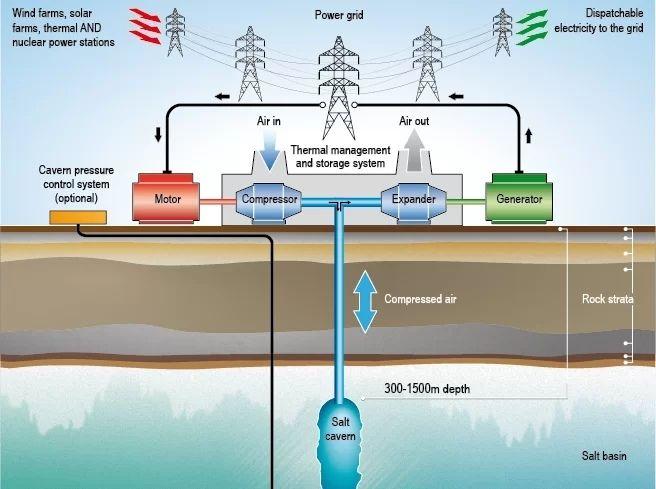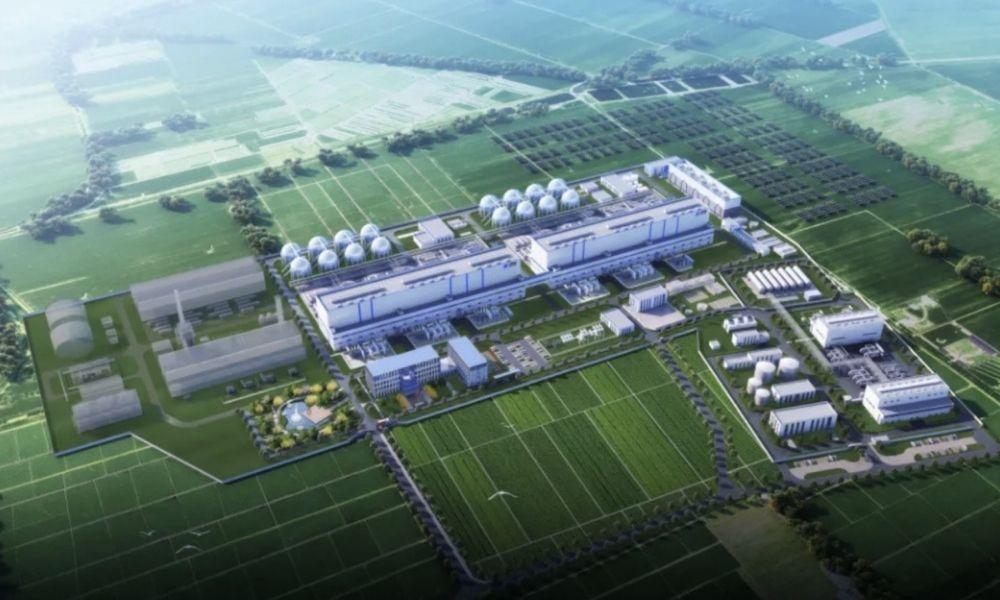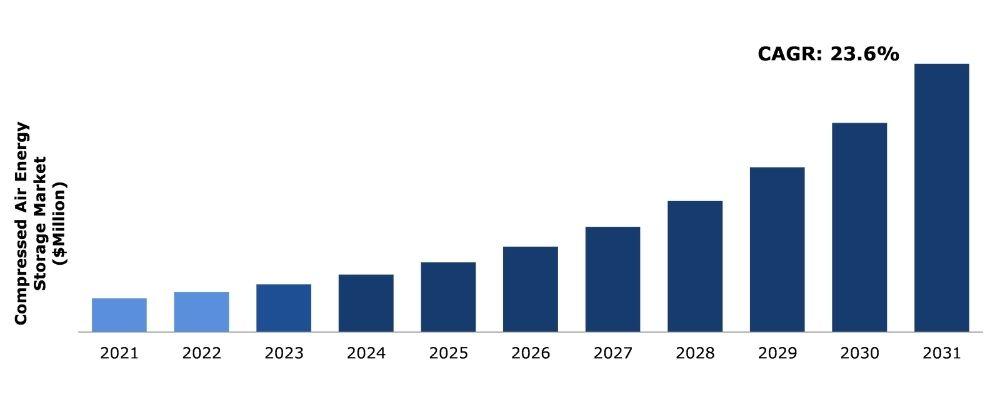What is Compressed Air Energy Storage?
Basic Principle
Compressed air energy storage(CAES) is an energy storage method that uses electrical energy for compressed air during low grid load periods and releases the compressed air to push the turbine to generate electricity during peak grid load periods.
A compressed air energy storage system generally consists of six main components:
Compressor: Generally multi-stage compressors with interstage cooling.
Expander: Usually a multi-stage turbine expander with inter-stage reheating equipment.
Combustion Chamber and Heat Exchanger: Used for fuel combustion and recovering waste heat.
Air Storage Device: Underground or above-ground caves or pressure vessels.
Motor/Generator: Connected to the compressor and the expander by means of a clutch, respectively.
Control System and Auxiliary Equipment: Includes control systems, fuel tanks, mechanical drive systems, piping, and fittings

Working Principle
The CAES system stores energy in the form of high-pressure air and generates electricity when needed by expanding the high-pressure air. The working process can be divided into two stages: energy storage and energy release.
Energy Storage Segment
The CAES system utilize wind/photovoltaic or low-valley electricity to drive a compressor that converts electrical energy into air pressure energy, and the high-pressure air is subsequently sealed and stored in scrapped mines, caverns, abandoned wells, or manmade storage tanks.
Energy Release Segment
By releasing high-pressure air to drive the expander, the stored air pressure energy is converted back into mechanical or electrical energy. Traditional CAES systems require the burning of fossil fuels in a combustion chamber to heat the air during the energy release phase in order to generate electricity from the air.
Classification of Compressed Air Energy Storage
Mechanical Compression Storage Systems
These systems compress air using mechanical devices and convert stored energy into electricity via generators.
Thermal Compression Storage Systems
These systems generate high-temperature gases using geothermal or solar energy, compressing and storing them, and then using the stored energy to generate electricity.
Liquid Air Energy Storage Systems
These systems compress air into a liquid state, storing it in tanks and converting it back to gas when needed to drive turbines for electricity generation.
Adsorption Air Energy Storage Systems
These systems use physical or chemical adsorption materials to compress and store air, releasing the stored energy via heat or depressurization when needed.

Advantages and Disadvantages
Advantages
Large Scale Storage: CAES systems are only second to pumped hydro storage in scale and can operate continuously for hours or even days.
Fewer Regional Restrictions: While storing compressed air in suitable underground mines or caverns is the most economical method, above-ground high-pressure storage tanks can also be used.
Long Lifespan: With proper maintenance, CAES systems can last 40 to 50 years, similar to pumped hydro storage, and can achieve efficiencies of over 60%.
High Safety: The raw material used in CAES is air, which is non-flammable and does not produce any toxic gases.
Disadvantages
Efficiency Issues: The efficiency of CAES currently reaches over 60%, which is relatively low compared to high-efficiency batteries (over 90%).
Slow Response Speed: CAES systems have a slower response time compared to electrochemical storage, with normal response times from 0 to 100% taking minutes, while electrochemical storage can respond in seconds or milliseconds.
Higher Costs: Generally, CAES is not suitable for very small-scale applications, as smaller systems may lead to decreased efficiency and increased unit costs.
Application Scenarios
Compressed air energy storage technology, due to its efficiency and flexibility, is widely used in various fields, primarily including:
Power Side
CAES systems are integrated with renewable energy generation systems such as wind and solar power, enhancing the quality and controllability of renewable electricity. By constructing integrated wind-storage or solar-storage systems, the stability and efficiency of renewable energy generation can be improved.
Grid Side
CAES can be directly connected to transmission or distribution networks and can receive unified dispatch from power scheduling organizations. It provides technical services such as peak shaving, frequency regulation, phase adjustment, backup, and black start, helping to alleviate transmission and distribution bottlenecks and enhance supply reliability.
Load Side
CAES can be coupled with thermal, geothermal, and industrial waste heat sources, and applied in industrial parks and public buildings, enhancing system layout flexibility and utilization efficiency.
Future Development Trends
Compressed air energy storage technology has strategic significance in the context of integrating high proportions of intermittent renewable energy sources into the grid. It can also be combined with other renewable energy sources to balance grid loads and enhance the stability of the power system. Furthermore, with technological advancements and cost reductions, CAES is expected to play an increasingly important role in future energy structures.

Conclusion
Compressed air energy storage is an effective energy storage technology that can play a significant role in utilizing renewable energy. Despite facing some challenges, its potential advantages make it a promising solution for the future energy transition. Through continuous technological innovation and optimization, CAES is expected to contribute to achieving a sustainable energy system.